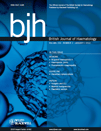Comment on Guidelines on oral anticoagulation with warfarin – 4th edition
In response to the recently updated guidance for anticoagulation with warfarin (Keeling et al, 2011), we were disappointed to note that there was no consideration given to the issue of left ventricular thrombus and anticoagulation. This is a not uncommonly encountered scenario, and one for which little robust evidence exists to assist with the management.
Left ventricular thrombus is commonly seen in the context of severely reduced ventricular function and low-flow states, and may occur in myocardial infarction or other non-ischaemic cardiomyopathy. Left ventricular thrombus may be asymptomatic and detected during investigations such as echocardiography or left ventriculography, or alternatively may give rise to cardio-embolic phenomena.
Once detected, there is little available evidence to guide duration of therapy in this group of patients, and the decision becomes even more complex in ischaemic cardiomyopathy with coronary artery stenting when patients are already on antiplatelet therapy.
As far back as 1983, immediate anticoagulation was advocated for all patients with left ventricular thrombus, and consideration of long-term anticoagulation in this group (Nixon, 1983). Küpper et al (1989) demonstrated an incidence of over 30% in 92 patients with acute anterior myocardial infarction, and these patients had a poorer outcome. Regression in size of the thrombus was seen in those treated with anticoagulation. Low levels of symptomatic systemic embolization were seen in this and other studies that demonstrated similar incidence (Visser et al, 1985; Johannessen et al, 1987; Keren et al, 1990). In a review, Cregler (1992) advocated 3 months of warfarin therapy for those with large anterior myocardial infarction or post-infarct heart failure. In all of the available literature, thrombus development was identified within 5 d of the index infarction and usually within 48 h. With current management of myocardial infarction, warfarinization of patients is no longer recommended.
We were unable to identify any recent evidence related to the management of left ventricular thrombus. Currently available evidence may no longer be applicable following the introduction and widespread use of the thienopyridine antiplatelet agents and the move away from thrombolysis toward primary coronary angioplasty for myocardial infarction. There is little available evidence in relation to the management of intracardiac thrombus in non-infarct related cardiomyopathies.
In our experience, this lack of evidence base has proved problematic in the management of such patients, and various strategies have been employed in their management with regard to warfarin therapy initiation and duration. This is especially problematic in those with drug eluting stents implanted.
With the recent advances in the management of heart disease, and continuing advances in echocardiography, including the adoption of micro-bubble contrast echo which will probably identify more cases of left ventricular thrombus, this is an area which requires further study and outcome data to aid with the management of this complex problem.




